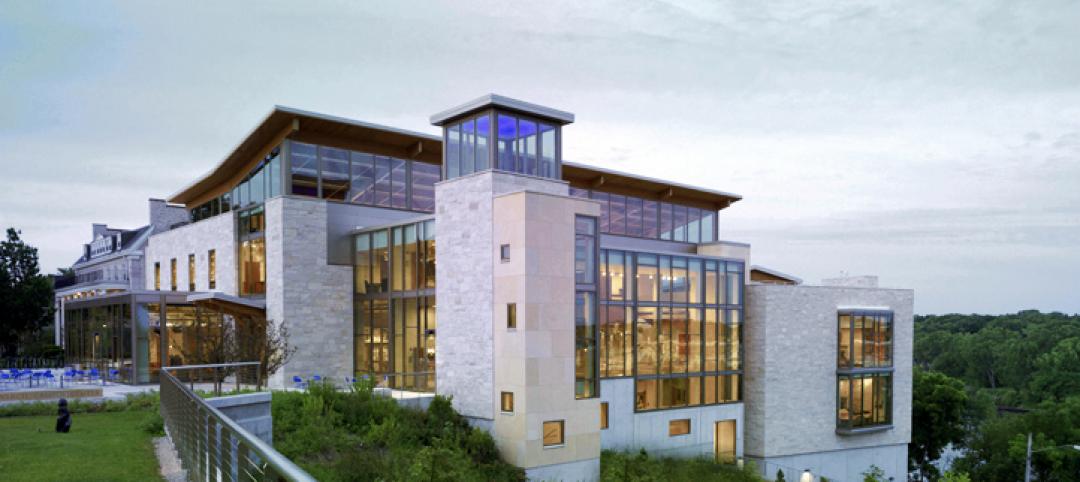The American Institute of Architects (AIA) Committee on Architecture for Education (CAE) has selected nine educational facilities for this year’s CAE Education Facility Design Awards.
The program honors educational facilities that the jury believes should serve as an example of a superb place in which to learn, furthering the client's mission, goals and educational program while demonstrating excellence in architectural design.
The jury for the 2015 Educational Facility Design Awards includes: J. Stuart Pettitt, AIA (Chair); Straub Pettitt Yaste Architects; William C. Ayers, education advocate; Victoria S. Bergsagel, Architects of Achievement; Mark Kranz, AIA, SmithGroup JJR; and Robert Miklos, FAIA, designLAB architects.
More information about the recipients here.
Berklee Tower; Berklee College of Music; Boston
Award of Excellence
William Rawn Associates, Architects, Inc.

All images courtesy of AIA
This 16-story mixed-use building is on the Berklee College of Music campus. A 40-foot-high performance and dining space shows student performances nightly and fronts onto a major Boston thoroughfare. Twelve floors, housing 380 students plus a fitness center and music practice rooms, sit above the performance space. Six double-height lounges on the residential floors link two floors of students. Two floors below grade house the largest recording studio complex in New England.
Health Sciences Education Building (HSEB); University of Arizona & Northern Arizona University; Phoenix
Award of Excellence
CO Architects with Ayers Saint Gross

The striated copper cladding helps protect against a harsh desert climate. The design meets the two universities’ desire for identity, sustainability and effective new learning environments. Many student-focused spaces encourage interaction between students and lecturers. The instructional elements of the project are organized in east-west blocks to minimize the building’s exposure to the intense Arizona sun. These blocks are located close together, creating a narrow “canyon”: a shaded space for outdoor gatherings and providing access to lecture halls.
University Center, The New School; New York City
Award of Excellence
Skidmore, Owings & Merrill LLP with SLCE Architects

With its 230,000-sf, seven-story campus center and 130,000-sf residential tower, the University Center reorganizes the elements of a traditional campus, from quads to classrooms and living quarters. Vertical, horizontal, and diagonal campus pathways ease movement through the building while increasing interaction among students and faculty. Academic spaces can be renovated or reconfigured with minimal impact on power, data, or lighting to meet changing needs.
Vashon Island High School; Vashon Island, Washington
Award of Excellence
Integrus Architecture

Located on a small island in Puget Sound, the design team sought to impart a quality of porosity to the new building. The concept of porosity defines how the building supports spatial connections and how students move in and out of the building. Shared areas are located adjacent to more formal teaching spaces, while a learning commons extends the library. A small group presentation room is located within the commons and a central courtyard provides sheltered outdoor learning areas.
Carl Sandburg Elementary School; Kirkland, Washington
Award of Merit
NAC|Architecture

Preserving the park-like feel of the northwest corner of Carl Sandburg Elementary School was central to the planning of the replacement school. The majority of the classroom neighborhoods are focused on a grove of 70-year-old Big Leaf maples, creating multiple outdoor learning spaces. The school has a capacity of 600 students in neighborhoods of either three or four classrooms. Each neighborhood is organized around an open learning area, small group rooms, and teacher planning areas.
Clough Undergraduate Learning Commons, Georgia Institute of Technology; Atlanta
Award of Merit
Bohlin Cywinski Jackson

The Clough Commons is at the center of Georgia Tech’s campus. The three dimensional grid of circulation and daylight frames large sections of furnished common spaces for student study, interaction and experiential learning. The building anchors campus circulation and frames Tech Green, the school’s central outdoor space. Clough Commons's landscaped roof garden is one of Tech’s most popular destination amenities.
Reed College Performing Arts Building; Portland, Oregon
Award of Merit
Opsis Architecture LLP

Reed College’s Performing Arts Building creates a 78,000-sf, cross-disciplinary home for the arts, like theatre, dance, and music programs. The building functions as the public front door to the campus. All performance and teaching spaces open to the three-level, light-filled, arts atrium merging informal and formal learning.
e3 Civic High School; San Diego
Walter Taylor Award
LPA, Inc.

The central circulation provides students with more than just a path of travel as the central steps and gallery space connecting the two floors. Every gathering space has a pull out or quiet area and every learning cluster or village has a small team room and a larger social space, all to support learning skills like critical thinking, collaboration, and communication.
Nueva School at Bay Meadows; San Mateo, California
Shirley Cooper Award
Leddy Maytum Stacy Architects

The Nueva School's new campus provides innovative educational spaces that supports cross disciplinary engagement and project-based inquiry. It fosters a strong community, models healthy, low-carbon living and learning, and adaptively reuses space at a former horse racing venue.
Related Stories
| Nov 4, 2011
Two Thornton Tomasetti projects win NCSEA’s 2011 Excellence in Structural Engineering Awards
Altra Sede Regione Lombardia and Bank of Oklahoma Center both recognized.
| Oct 17, 2011
Clery Act report reveals community colleges lacking integrated mass notification systems
“Detailed Analysis of U.S. College and University Annual Clery Act Reports” study now available.
| Oct 14, 2011
University of New Mexico Science & Math Learning Center attains LEED for Schools Gold
Van H. Gilbert architects enhances sustainability credentials.
| Oct 12, 2011
Bulley & Andrews celebrates 120 years of construction
The family-owned and operated general contractor attributes this significant milestone to the strong foundation built decades ago on honesty, integrity, and service in construction.
| Sep 30, 2011
Design your own floor program
Program allows users to choose from a variety of flooring and line accent colors to create unique floor designs to complement any athletic facility.
| Sep 23, 2011
Okanagan College sets sights on Living Buildings Challenge
The Living Building Challenge requires projects to meet a stringent list of qualifications, including net-zero energy and water consumption, and address critical environmental, social and economic factors.
| Sep 14, 2011
Research shows large gap in safety focus
82% of public, private and 2-year specialized colleges and universities believe they are not very effective at managing safe and secure openings or identities.
| Sep 7, 2011
KSS Architects wins AIA NJ design award
The project was one of three to win the award in the category of Architectural/Non-Residential.
| May 18, 2011
Major Trends in University Residence Halls
They’re not ‘dorms’ anymore. Today’s collegiate housing facilities are lively, state-of-the-art, and green—and a growing sector for Building Teams to explore.















